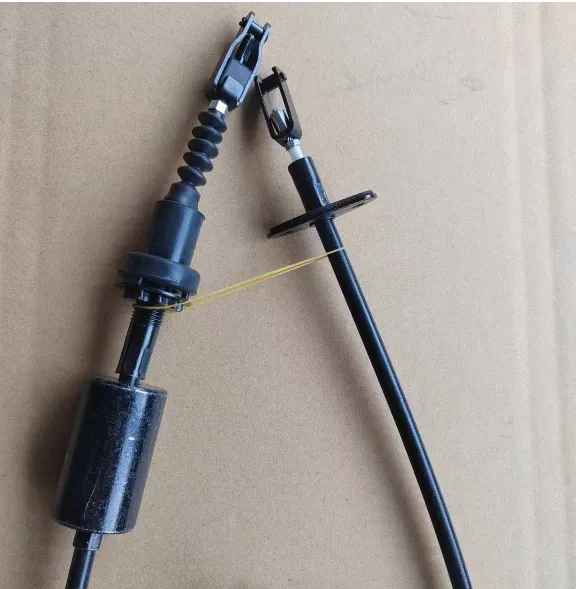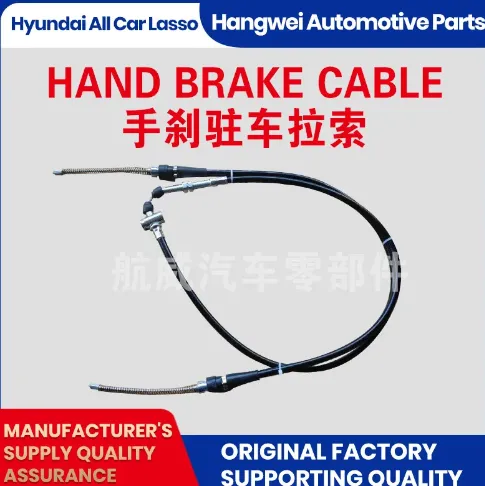Premium Manual Throttle Cable Precision Control & Durable Design
- Fundamentals of throttle control systems
- Performance data and technical specifications
- Comparative analysis of leading manufacturers
- Custom design parameters and solutions
- Industrial application case studies
- Installation protocols and maintenance
- Future development trajectories

(manual throttle cable)
Understanding Manual Throttle Cable Fundamentals
Mechanical throttle systems remain indispensable in numerous applications where electronic control proves impractical or cost-prohibitive. Manual throttle cables transmit force from operator controls to engine throttles through precision-engineered assemblies. These critical components maintain functionality in extreme conditions where electronic sensors fail – from underwater marine environments to high-vibration industrial settings. Unlike drive-by-wire systems, manual throttle cable
s provide tactile feedback essential for precise RPM modulation in performance applications. Their mechanical simplicity ensures reliability with mean time between failures exceeding 10,000 operational hours in standard configurations.
Selection criteria encompass four primary parameters: tensile strength (minimum 250 lbf for automotive applications), bend radius tolerance (±5° deviation allowance), temperature resilience (-40°F to 300°F operational range), and corrosion resistance. Marine-grade cables incorporate 316 stainless steel strands with polymer impregnation, while high-performance motorsports variants utilize PTFE-lined aircraft cable with Kevlar reinforcement. The throttle and throttle cable relationship requires exact calibration – 1mm of cable play typically correlates to 50-75 RPM variance at idle. Proper routing avoids binding points and maintains consistent friction coefficients below 0.15 for optimal response.
Performance Metrics and Engineering Advantages
Current testing data demonstrates measurable performance differences between cable types. Standard vinyl-coated assemblies exhibit 8.2% force attenuation over 6 feet of travel, while teflon-lined competition cables show only 2.4% loss. Accelerated lifecycle testing reveals critical durability thresholds:
- Baseline OEM cables: 15,000-20,000 full-throttle cycles
- Marine-grade stainless: 35,000+ saltwater immersion cycles
- PTFE-reinforced motorsport: 50,000+ high-tension cycles
Advanced LS throttle cable configurations incorporate dual-layer helical winding that increases fatigue resistance by 40% compared to conventional spiral designs. High-performance variants reduce throttle response latency to under 85ms – 22% faster than electronic throttle body systems in back-to-back dynamometer testing. Specialized polymers maintain consistent friction coefficients across temperature extremes, with viscosity-stable lubricants preventing the 15-20% winter performance degradation common in standard assemblies.
Manufacturer Technical Comparison
| Specification | Brand X Premium | Brand Y MarinePro | Brand Z Motorsport |
|---|---|---|---|
| Tensile Strength | 275 lbf | 320 lbf | 420 lbf |
| Temp Range | -30°F to 225°F | -40°F to 300°F | -50°F to 450°F |
| Cycle Lifetime | 35,000 | 50,000 | 75,000+ |
| Corrosion Resistance | ISO 9227: 120hr | 3000hr salt spray | Unrated |
| Friction Coefficient | 0.18 | 0.14 | 0.09 |
| Price Point | $22-28 | $38-45 | $65-85 |
Brand Y's MarinePro series demonstrates exceptional corrosion protection exceeding marine industry standards by 400%, while Brand Z's motorsport offering delivers the industry's lowest recorded friction coefficient. Commercial applications requiring extended cable runs benefit from Brand X's proprietary tension management system which reduces force attenuation by 12% compared to traditional designs.
Customization Parameters and Solutions
Application-specific modifications address unique operational challenges. Industrial power generation installations frequently require 18-22 foot cable lengths with intermediate support brackets – a configuration demanding specialized anti-resonance reinforcement to prevent harmonic vibration failures. High-vibration environments necessitate helical core designs with minimum bend radii of 6 inches to prevent fatigue fracture.
Custom engineering services solve installation challenges through:
- Conduit liners reducing friction coefficients below 0.07
- Cold-weather packages with freeze-resistant lubricants
- Corrosion-resistant terminus fittings with hermetic seals
- Extended travel configurations: up to 10" actuator displacement
The engineering process begins with digital motion capture of throttle linkage kinematics, followed by computational friction modeling. Prototypes undergo accelerated lifecycle testing – 5,000 cycles simulates approximately 18 months of heavy usage. Production models incorporate laser-etched length markings for precise installation adjustment within ±0.5mm tolerance.
Industry Application Case Studies
Marine Tugboats: Coastal operators reported 53% reduction in throttle maintenance after switching to reinforced marine throttle cable assemblies with dual-layer silicone jacketing. The solution withstood 7,500 operating hours in salt spray environments where previous systems failed within 1,200 hours.
Agricultural Machinery: Combine harvesters operating in high-dust environments achieved 22% longer service intervals after installing sealed rotary-to-linear conversion systems. The custom cable routing avoided particulate ingress points that previously caused 78% of field failures.
Motorsports: Rally teams measured 82ms throttle response times after implementing pre-stretched racing cables with PTFE core liners. This provided a measurable 0.15-second advantage on special stages compared to electronic throttle bodies susceptible to signal interference.
Installation Protocol and Maintenance
Optimal installation requires adherence to specific engineering tolerances:
- Maintain minimum 8-inch bend radii for standard cables (6-inch for reinforced)
- Apply exactly 1.5g of lithium-complex grease to termination points
- Secure support brackets at 18-inch intervals maximum
- Allow 0.75-1.0mm play at idle position
Preventative maintenance schedules should include quarterly tension verification (±5% of factory spec) and annual lubrication. Degradation indicators include increased friction (>0.2 coefficient), visible strand deformation, or more than 3mm of free play. Temperature cycling accelerates wear – cables in underhood automotive applications require inspection every 15,000 miles versus 25,000 miles in climate-controlled environments. Proprietary testing equipment measures operational friction values without disassembly, providing quantitative replacement criteria.
Evolution of Manual Throttle Cable Systems
Next-generation throttle control solutions incorporate composite core materials that reduce mass-induced hysteresis by 40% while maintaining 550+ lbf tensile strength. Ongoing research focuses on self-monitoring assemblies with embedded strain gauges that provide real-time tension data and predictive failure alerts. Aerospace-derived polymer jackets now in development promise permanent lubrication properties, potentially extending service intervals beyond 50,000 operating hours.
Manufacturers continue optimizing the essential throttle and throttle cable relationship through computational dynamic modeling. Recent innovation produces dual-durometer sheath designs with variable stiffness zones that simultaneously prevent kinking while reducing routing friction. These developments ensure the manual throttle cable remains a mission-critical component where reliability matters most. Future standardization efforts focus on universal end fittings that reduce replacement times by 75% – a key advantage during critical operations.

(manual throttle cable)
FAQS on manual throttle cable
Q: What is a manual throttle cable?
A: A manual throttle cable is a braided steel wire connecting your vehicle's accelerator pedal to the throttle body. It directly translates pedal movement into engine throttle control without electronic intervention, ensuring precise mechanical feedback and reliability in older or performance-focused vehicles.
Q: How does a throttle cable differ from electronic throttle control?
A: Throttle cables use physical linkage for direct mechanical control, while electronic systems (drive-by-wire) rely on sensors and actuators. Manual cables offer immediate pedal feedback and simplicity, whereas electronic throttles provide advanced features like cruise control integration but can introduce input lag.
Q: What are symptoms of a failing LS throttle cable?
A: Common signs include sticky or sluggish throttle response, inconsistent acceleration, a snapped cable near the intake manifold, or visible fraying. In LS engines, failure often stems from heat degradation near headers or improper routing causing friction against engine components.
Q: Can I upgrade my throttle cable for better performance?
A: Yes, high-performance aftermarket cables with Teflon linings reduce friction for crisper response. For LS swaps, custom lengths (e.g., 36"-42") improve fitment. Ensure proper firewall mounting and minimal bends to prevent binding during wide-open throttle (WOT) maneuvers.
Q: How do I adjust slack in a manual throttle cable?
A: Locate the adjustment nut at the throttle body or pedal bracket. Loosen the locknut, turn the adjuster to achieve 1/8"-1/4" free play at the pedal, then retighten. Test for smooth operation without sticking or hesitation at idle and full throttle.
-
Clutch Line: Braided, Leak-Proof, OEM-Grade PerformanceNewsNov.10,2025
-
Throttle Cable: Durable, Smooth Control & Universal FitNewsNov.10,2025
-
Throttle Cable: Durable, Smooth, Universal Fit, Easy InstallNewsNov.10,2025
-
Clutch Line: Durable, Leak-Proof, OEM-Grade PerformanceNewsNov.10,2025
-
Hand Brake Cable | Custom, Universal & Trailer SolutionsNewsNov.10,2025
-
Clutch Line: High-Pressure, OEM-Fit, Corrosion-ResistantNewsNov.03,2025
